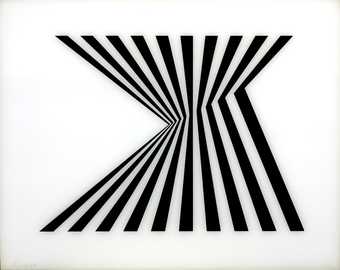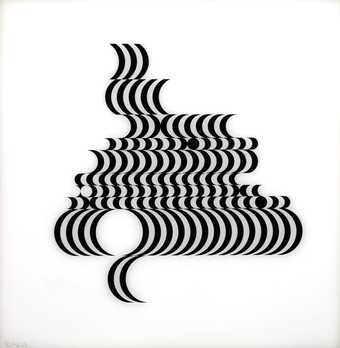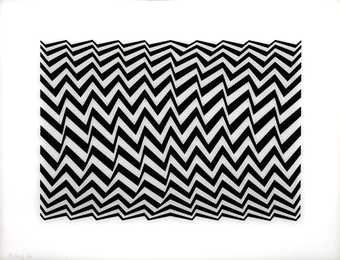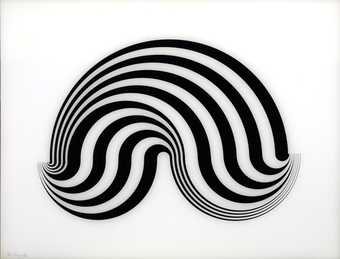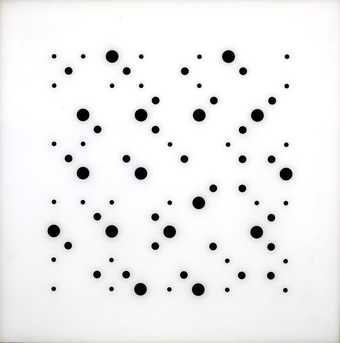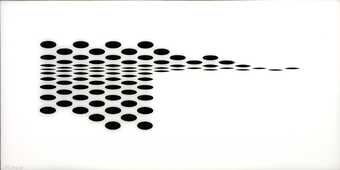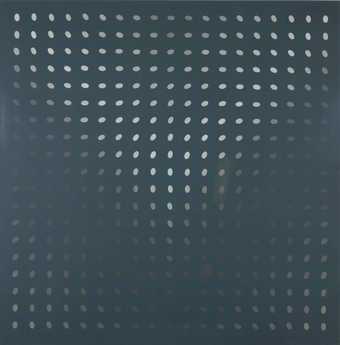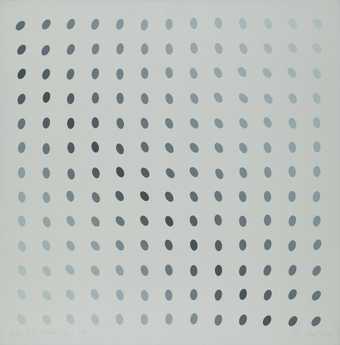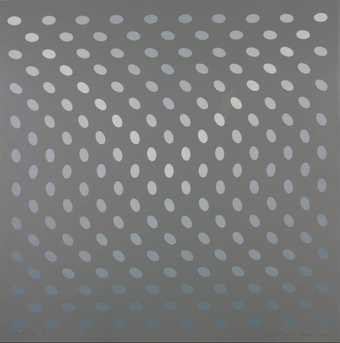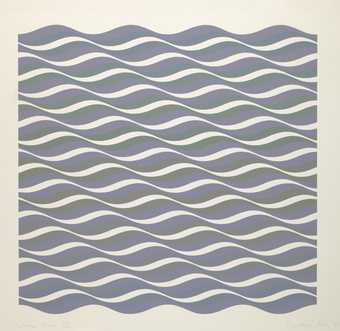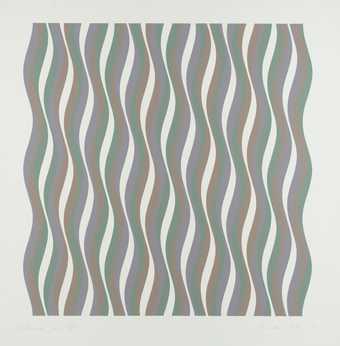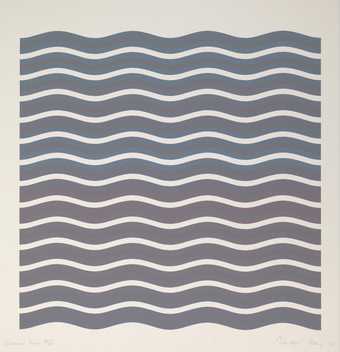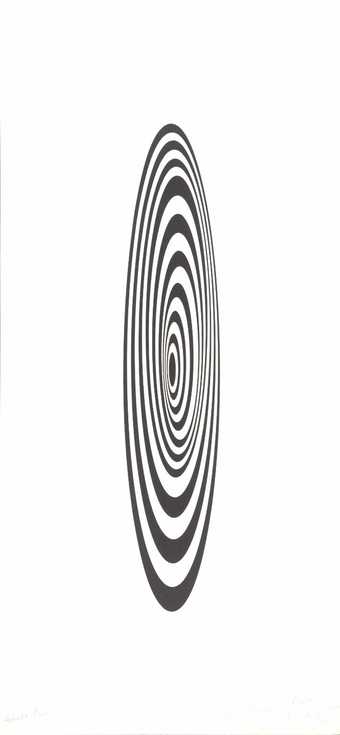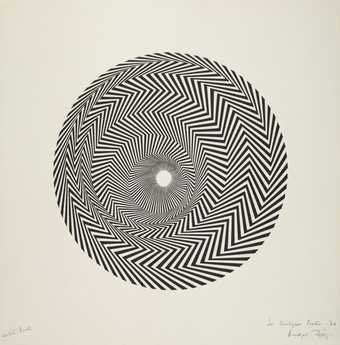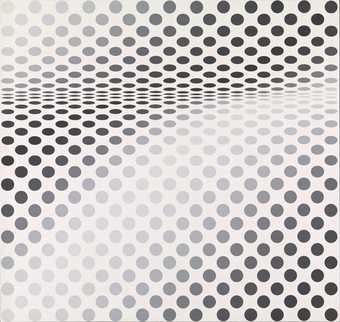
In Tate St Ives
- Artist
- Bridget Riley born 1931
- Part of
- Nineteen Greys
- Medium
- Screenprint on paper
- Dimensions
- Image: 756 × 749 mm
- Collection
- Tate
- Acquisition
- Purchased 1970
- Reference
- P07111
Catalogue entry
Bridget Riley b. 1934
P07111-P07114 Nineteen Greys 1968
Four screen prints on Saunders Board, each 29¾ x 29½ (75.6 x 75).
P07114 A: Inscribed ‘Artist’s Proof Nineteen Greys ‘68’ b.l. and ‘Bridget Riley’ b.r.
P07113 B: Inscribed ‘Bridget Riley ‘68’ b.l. and ‘Nine Greys Artist’s Proof’ b.r.
P07111 C: Inscribed ‘Artist’s Proof Nineteen Greys ‘68’ b.l. and ‘Bridget Riley’ b.r.
P07112 D: Inscribed ‘Artist’s Proof Nineteen Greys ‘68’ b.l. and ‘Bridget Riley’ b.r. Purchased from the Neuendorf Verlag, Hamburg (Gytha Trust) 1970.
Lit: Maurice de Sausmarez, ‘Bridget Riley’ 1970 repr. (i) p.79, (iii) p.78. Gene Baro, ‘Bridget Riley’s Nineteen Greys’ in Studio International, CLXXVI, 1968, p. 280 repr. all prints.
The title, ‘Nineteen Greys’ refers to the fact that the four prints are printed with nineteen different greys. The suite was published by the Rowan Gallery and printed at the Kelpra Studio in an edition of 75.
The artist told the compiler (February 1972) that the following account, which she gave to Gene Baro as the catalogue introduction to her exhibition at the Rowan Gallery in 1968, was the most satisfactory description of her work.
The four prints developed from particular aspects of a series of studies for paintings.
Her interest in the media of print was in the way it related to her preoccupation as a painter, rather than in how it was the traditional vehicle for reproduction. She began to sec some of her images as print. The print technique seems to allow, even compel the images she was visualising: also print technique gave the desired qualities without making the production of them an issue. The inks naturally provided the ideal luminosity, and sustained subtle tonal gradations that she required, and the printing off ered the crisp edges, the absolute flatness and powdery overlay of colour. The particular scriographical effects of the work could not have been approximated to by painting.
The artist also believed that a sheet of paper and not a large canvas was more appropriate to what she was establishing, by the images.
Baro wrote: ‘Nineteen Greys is based upon the idea and sensation of denial. It involves certain visual juxtapositions and confrontations where the elements or their activities neutralise one another, cancel one another out. The central subject of the prints is the result of this neutralisation or cancellation.
‘What are these elements specifically? First of all, the grid; then, the angles; finally, the tonal movement. Each of these three organisational systems is made to move against the other two.
‘In these prints, the principle of regularity is expressed overtly in a grid system of unvarying intervals. The grid may be organised according to the right angles or diagonals. The angle movement is made to operate against the normal structure of these two kinds of grid, flowing from horizontal to vertical or from vertical to horizontal diagonally. In all of these prints, the angle movement departs from its original state to achieve its opposite and by degrees returns to its former orientation. The movement of reversal and return may be fast or slow. A variable movement is played against the equidistant beat of the grid. The movement consists of two systems, light-dark, warm-cold. Fundamentally in this suite there are two warm grey grounds against which the cold grey ovals are pitched and two cold grey grounds in reaction to ovals in warm grey. The tonal structure provided both a contrast in terms of light and dark and, where contrast is reduced or absent, a release of colour—emphasis upon sheer hue. Up to nineteen greys are used in the prints, tones filled with colour. In each print, the directional flow of the tones is at variance with movement of the angles and the structure of the grid.’
Published in The Tate Gallery Report 1970–1972, London 1972.
Explore
- abstraction(8,615)
-
- non-representational(6,161)
-
- geometric(3,072)
- monochromatic(722)
- formal qualities(12,454)
-
- pattern(358)
- visual illusion(118)
You might like
-
Bridget Riley Untitled [Fragment 1/7]
1965 -
Bridget Riley Untitled [Fragment 2/10]
1965 -
Bridget Riley Untitled [Fragment 3/11]
1965 -
Bridget Riley Untitled [Fragment 5/8]
1965 -
Bridget Riley Untitled [Fragment 6/9]
1965 -
Bridget Riley Untitled [Fragment 7/5]
1965 -
Bridget Riley Untitled [Nineteen Greys D]
1968 -
Bridget Riley Untitled [Nineteen Greys B]
1968 -
Bridget Riley Untitled [Nineteen Greys A]
1968 -
Bridget Riley Coloured Greys III
1972 -
Bridget Riley Coloured Greys I
1972 -
Bridget Riley Coloured Greys II
1972 -
Bridget Riley Untitled
1964 -
Bridget Riley Blaze
1964 -
Bridget Riley Hesitate
1964

